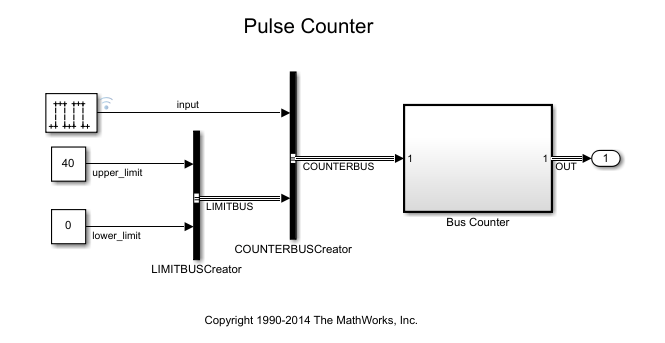getSignalsByName
Access signals in a Simulink.sdi.Run object using signal
name
Description
sigs = getSignalsByName(runObj,name)Simulink.sdi.Signal objects with the name
specified by name.
Examples
You can use the Simulation Data Inspector programmatic interface to access Simulink.sdi.Signal objects that correspond to logged or imported data. Using the getSignalsByName function, you can specify the name of the signal you want to get from a Simulink.sdi.Run object. You can access data for individual signals and composite signals.
Create Data in the Simulation Data Inspector
This example uses a model of a pulse counter to create simulation data in the Simulation Data Inspector. The model has two input signals that define the upper and lower limit for the counter, and one input pulse signal with pulses to count. The model uses buses to send data into the Bus Counter subsystem and out of it to an Outport block. The model is configured to log the pulse signal, input, and the output connected to the Outport block.

Simulate the model to create a run that contains the logged data in the Simulation Data Inspector.
out = sim('ex_pulse_counter');Access Signals in the Simulation Data Inspector
Use the Simulation Data Inspector programmatic interface to access the logged data. The Simulink.sdi.Run.getLatest function returns the Simulink.sdi.Run object that corresponds to the most recently created run.
countRun = Simulink.sdi.Run.getLatest;
Use the getSignalsByName function to access the input signal. Check the Name property of the returned Simulink.sdi.Signal object.
inSig = getSignalsByName(countRun,'input');
inSig.Nameans = 'input'
The input signal is not a composite signal, so the Children property of the Signal object is empty.
inChildren = inSig.Children; size(inChildren)
ans = 1×2
0 0
Now, use the getSignalsByName function to access the output signal, OUT. OUT is a bus signal that contains the output signal from the counter, output, and the counter limit signals, upper_limit and lower_limit, in a nested bus named LIMITBUS.
outSig = getSignalsByName(countRun,'OUT');Check the Name and Children properties for the returned Signal object. The Children property value contains two Signal objects that correspond to the signals at the next level of hierarchy in the OUT bus.
outSig.Name
ans = 'OUT'
outChildren = outSig.Children; size(outChildren)
ans = 1×2
1 2
Because the Signal object outSig corresponds to a composite signal, you cannot plot the signal data in the Simulation Data Inspector using the Checked property or the plotOnSubPlot function. To plot data in the composite signal, access the individual Signal objects.
Access Signals Inside a Composite Signal
You can access the signals inside the OUT bus and LIMITBUS by indexing into the Children property of the corresponding Signal object. For example, you can access the output signal from the OUT bus Signal object.
outChildren = outSig.Children; outputSig = outChildren(1); outputSig.Name
ans = 'OUT.output'
You can also get the Signal object for the output signal by specifying the path to the signal through the bus hierarchy.
outputSig = getSignalsByName(countRun,'OUT.output');
outputSig.Nameans = 'OUT.output'
To access the upper_limit signal, specify the full path to the signal within the bus.
upper_limitSig = getSignalsByName(countRun,'OUT.LIMITBUS.upper_limit');
upper_limitSig.Nameans = 'OUT.LIMITBUS.upper_limit'
Input Arguments
Run containing the signals you want to access, specified as a Simulink.sdi.Run object.
Name of the signal you want to access, specified as a character vector or string.
A model can use the same signal name for more than one signal. In that case, when
you want to access a specific signal, you can include the block path for the block that
produces the signal in the name argument. For example, specify
name as 'slexAircraftExample.Pilot.Stick' to
access the signal named Stick that is the output of the
Pilot block in the slexAircraftExample
model.
To access signals inside composite signals, specify the path to the signal through
the hierarchy of the composite signal. For example, specify name as
'COUNTERBUS.LIMITBUS.lower_limit' to access the
lower_limit signal inside the bus LIMITBUS that
is nested in the bus COUNTERBUS.
Data Types: char | string
Output Arguments
One or more signals matching the specified name, returned as a Simulink.sdi.Signal object or an array of
Simulink.sdi.Signal objects.
Version History
Introduced in R2020a
MATLAB Command
You clicked a link that corresponds to this MATLAB command:
Run the command by entering it in the MATLAB Command Window. Web browsers do not support MATLAB commands.
Select a Web Site
Choose a web site to get translated content where available and see local events and offers. Based on your location, we recommend that you select: .
You can also select a web site from the following list
How to Get Best Site Performance
Select the China site (in Chinese or English) for best site performance. Other MathWorks country sites are not optimized for visits from your location.
Americas
- América Latina (Español)
- Canada (English)
- United States (English)
Europe
- Belgium (English)
- Denmark (English)
- Deutschland (Deutsch)
- España (Español)
- Finland (English)
- France (Français)
- Ireland (English)
- Italia (Italiano)
- Luxembourg (English)
- Netherlands (English)
- Norway (English)
- Österreich (Deutsch)
- Portugal (English)
- Sweden (English)
- Switzerland
- United Kingdom (English)